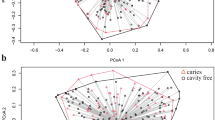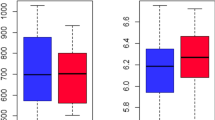Abstract
Objective
This study aimed to explore oral microbiome diversity among children with various caries status based on dmft scores.
Methods
A total of 320 children aged 3–5 years were recruited, with 66 healthy children and 254 children affected by dental caries. According to dmft scores, these children with dental caries were classified as “mild group” (dmft score 1–3), “moderate group” (dmft score 4–6), and “severe group” (dmft score 7–14). Healthy children with dmft score of 0 served as control group. Illumina MiSeq sequencing was employed to analyze all salivary samples collected from these children.
Results
The salivary microbial diversity among four groups was similar (p > 0.05). A total of five bacterial genera were highly abundant in the control group including Bergeyella, Acidimicrobiales, Acidimicrobiia, Halomonas, and Blautia (p < 0.05). For mild group, there were nine bacterial genera identified to be predominant: Porphyromonadaceae, Porphyromonas, Enterobacteriales, Enterobacteriaceae, Weissella, Leuconostocaceae, Alphaproteobacteria, Stenotrophomonas, and Rhizobiales (p < 0.05). Only one genus, Aggregatibacter was predominant in moderate group (p < 0.05). There were six bacterial genera (Alistipes, Lachnoclostridium, Escherichia-Shigella, Romboutsia, Sphingomonadales, and Denitratisoma) enriched in severe group (p < 0.05).
Conclusion
Oral microbial profile was different in children with various caries status based on dmft scores.
Clinical relevance
The results might be beneficial to deeply understand microbiological diversity of early childhood caries (ECC) at various stages and inform effective strategies for ECC prevention.











Similar content being viewed by others
Data availability
Data will be uploaded as supplementary material and deposited in a public accessible database.
References:
Vos T, Abajobir AA, Abate KH, Abbafati C, Abbas KM, Abd-Allah F, Abdulkader RS, Abdulle AM, Abebo TA, Abera SF,: GBD, et al (2016) Disease and Injury Incidence and Prevalence Collaborators (2017) Global, regional, and national incidence, prevalence, and years lived with disability for 328 diseases and injuries for 195 countries, 1990–2016: a systematic analysis for the Global Burden of Disease Study 2016. Lancet 390:1211–1259
Neves ÉTB, Firmino RT, de França PM, Gomes MC, Martins CC, Paiva SM, Granville-Garcia AF (2016) Absenteeism among preschool children due to oral problems. J Public Health 24(1):65–72
Ladrillo TE, Hobdell MH, Caviness AC (2006) Increasing prevalence of emergency department visits for pediatric dental care, 1997–2001. J Am Dent Assoc 137(3):379–385
Vieira-Andrade RG, Gomes GB, de Almeida Pinto-Sarmento TC, Firmino RT, Pordeus IA, Ramos-Jorge ML, Paiva SM, Granville-Garcia AF (2016) Oral conditions and trouble sleeping among preschool children. J Publ Health 24(5):395–400
Parisotto TM, Steiner-Oliveira C, Silva CM, Rodrigues LK, Nobre-dos-Santos M (2010) Early childhood caries and mutans streptococci: a systematic review. Oral Health Prev Dent 8(1):59–70
Gross EL, Beall CJ, Kutsch SR, Firestone ND, Leys EJ, Griffen AL (2012) Beyond Streptococcus mutans: dental caries onset linked to multiple species by 16S rRNA community analysis. PLoS ONE 7(10):e47722
Corby PM, Lyons-Weiler J, Bretz WA, Hart TC, Aas JA, Boumenna T, Goss J, Corby AL, Junior HM, Weyant RJ, Paster BJ (2005) Microbial risk indicators of early childhood caries. J Clin Microbiol 43(11):5753–5759
Ling Z, Kong J, Jia P, Wei C, Wang Y, Pan Z, Huang W, Li L, Chen H, Xiang C (2010) Analysis of oral microbiota in children with dental caries by PCR-DGGE and barcoded pyrosequencing. Microb Ecol 60(3):677–690
Jiang S, Gao X, Jin L, Lo EC (2016) Salivary microbiome diversity in caries-free and caries-affected children. Int J Mol Sci 17(12):1978
Kanasi E, Johansson I, Lu SC, Kressin NR, Nunn ME, Kent R Jr, Tanner AC (2010) Microbial risk markers for childhood caries in pediatricians’ offices. J Dent Res 89(4):378–383
Grier A, Myers JA, O’Connor TG, Quivey RG, Gill SR, Kopycka-Kedzierawski DT (2021) Oral microbiota composition predicts early childhood caries onset. J Dent Res 100(6):599–607
Wang Y, Zhang J, Chen X, Jiang W, Wang S, Xu L, Tu Y, Zheng P, Wang Y, Lin X et al (2017) Profiling of oral microbiota in early childhood caries using single-molecule real-time sequencing. Front Microbiol 8:2244
Palmer CA, Kent R Jr, Loo CY, Hughes CV, Stutius E, Pradhan N, Dahlan M, Kanasi E, Arevalo Vasquez SS, Tanner AC (2010) Diet and caries-associated bacteria in severe early childhood caries. J Dent Res 89(11):1224–1229
Ma C, Chen F, Zhang Y, Sun X, Tong P, Si Y, Zheng S (2015) Comparison of oral microbial profiles between children with severe early childhood caries and caries-free children using the human oral microbe identification microarray. PLoS ONE 10(3):e0122075
Tanner AC, Mathney JM, Kent RL, Chalmers NI, Hughes CV, Loo CY, Pradhan N, Kanasi E, Hwang J, Dahlan MA, Papadopolou E, Dewhirst FE (2011) Cultivable anaerobic microbiota of severe early childhood caries. J Clin Microbiol 49(4):1464–1474
Agnello M, Marques J, Cen L, Mittermuller B, Huang A, Chaichanasakul Tran N, Shi W, He X, Schroth RJ (2017) Microbiome associated with severe caries in Canadian First Nations children. J Dent Res 96(12):1378–1385
Jiang W, Zhang J, Chen H (2013) Pyrosequencing analysis of oral microbiota in children with severe early childhood dental caries. Curr Microbiol 67(5):537–542
Zhang L, Sun T, Zhu P, Sun Z, Li S, Li F, Zhang Y, Tan K, Lu J, Yuan R et al (2020) Quantitative analysis of salivary oral bacteria associated with severe early childhood caries and construction of caries assessment model. Sci Rep 10(1):6365
Meriç E, Bolgül B, Duran N, Ay E (2020) Evaluation of oral streptococci in saliva of children with severe early childhood caries and caries-free. Eur J Paediatr Dent 21(1):13–17
Xiao J, Grier A, Faustoferri RC, Alzoubi S, Gill AL, Feng C, Liu Y, Quivey RG, Kopycka-Kedzierawski DT, Koo H, Gill SR (2018) Association between oral Candida and Bacteriome in children with severe ECC. J Dent Res 97(13):1468–1476
de Carvalho FG, Silva DS, Hebling J, Spolidorio LC, Spolidorio DM (2006) Presence of mutans streptococci and Candida spp. in dental plaque/dentine of carious teeth and early childhood caries. Arch Oral Biol 51(11):1024–1028
Zhang T, Hong J, Yu X, Liu Q, Li A, Wu Z (2021) Zeng X (2021) Association between socioeconomic status and dental caries among Chinese preschool children: a cross-sectional national study. BMJ Open 11(5):e042908
Xu H, Hao W, Zhou Q, Wang W, Xia Z, Liu C, Chen X, Qin M, Chen F (2014) Plaque bacterial microbiome diversity in children younger than 30 months with or without caries prior to eruption of second primary molars. PLoS ONE 9(2):e89269
Li Y, Ge Y, Saxena D, Caufield PW (2007) Genetic profiling of the oral microbiota associated with severe early-childhood caries. J Clin Microbiol 45(1):81–87
Xiao C, Ran S, Huang Z, Liang J (2016) Bacterial diversity and community structure of supragingival plaques in adults with dental health or caries revealed by 16S pyrosequencing. Front Microbiol 7:1145
Hurley E, Barrett MPJ, Kinirons M, Whelton H, Ryan CA, Stanton C, Harris HMB, O’Toole PW (2019) Comparison of the salivary and dentinal microbiome of children with severe-early childhood caries to the salivary microbiome of caries-free children. BMC Oral Health 19(1):13
Kim Seow W (2012) Environmental, maternal, and child factors which contribute to early childhood caries: a unifying conceptual model. Int J Paediatr Dent 22(3):157–168
Johansson I, Witkowska E, Kaveh B, Lif Holgerson P, Tanner AC (2016) The microbiome in populations with a low and high prevalence of caries. J Dent Res 95(1):80–86
Bik EM, Long CD, Armitage GC, Loomer P, Emerson J, Mongodin EF, Nelson KE, Gill SR, Fraser-Liggett CM, Relman DA (2010) Bacterial diversity in the oral cavity of 10 healthy individuals. ISME J 4(8):962–974
Park OJ, Yi H, Jeon JH, Kang SS, Koo KT, Kum KY, Chun J, Yun CH, Han SH (2015) Pyrosequencing analysis of subgingival microbiota in distinct periodontal conditions. J Dent Res 94(7):921–927
Jeon CO, Lim JM, Lee JR, Lee GS, Park DJ, Lee JC, Oh HW, Kim CJ (2007) Halomonas kribbensis sp. nov., a novel moderately halophilic bacterium isolated from a solar saltern in Korea. Int J Syst Evol Microbiol 57(Pt 10):2194–2198
Kim MS, Park EJ (2014) Bacterial communities of traditional salted and fermented seafoods from Jeju Island of Korea using 16S rRNA gene clone library analysis. J Food Sci 79(5):M927-934
Signoretto C, Burlacchini G, Bianchi F, Cavalleri G, Canepari P (2006) Differences in microbiological composition of saliva and dental plaque in subjects with different drinking habits. New Microbiol 29(4):293–302
Liu X, Mao B, Gu J, Wu J, Cui S, Wang G, Zhao J, Zhang H, Chen W (2021) Blautia-a new functional genus with potential probiotic properties? Gut Microbes 13(1):1–21
Gamboa F, García DA, Acosta A, Mizrahi D, Paz A, Martínez D, Arévalo A, Aristizabal F, Abba M (2013) Presence and antimicrobial profile of gram-negative facultative anaerobe rods in patients with chronic periodontitis and gingivitis. Acta Odontol Latinoam 26(1):24–30
Goldberg S, Cardash H, Browning H, Sahly H, Rosenberg M (1997) Isolation of Enterobacteriaceae from the mouth and potential association with malodor. J Dent Res 76(11):1770–1775
Gomez A, Espinoza JL, Harkins DM, Leong P, Saffery R, Bockmann M, Torralba M, Kuelbs C, Kodukula R, Inman J, Hughes T, Craig JM, Highlander SK, Jones MB, Dupont CL, Nelson KE (2017) Host genetic control of the oral microbiome in health and disease. Cell Host Microbe 22(3):269–278
Parker BJ, Wearsch PA, Veloo ACM, Rodriguez-Palacios A (2020) The genus Alistipes: gut bacteria with emerging implications to inflammation, cancer, and mental health. Front Immunol 11:906
Jiang W, Ling Z, Lin X, Chen Y, Zhang J, Yu J, Xiang C, Chen H (2014) Pyrosequencing analysis of oral microbiota shifting in various caries states in childhood. Microb Ecol 67(4):962–969
Neves BG, Stipp RN, Bezerra DDS, Guedes SFF, Rodrigues LKA (2018) Quantitative analysis of biofilm bacteria according to different stages of early childhood caries. Arch Oral Biol 96:155–161
Xu L, Chen X, Wang Y, Jiang W, Wang S, Ling Z, Chen H (2018) Dynamic alterations in salivary microbiota related to dental caries and age in preschool children with deciduous dentition: a 2-year follow-up study. Front Physiol 9:342
Acknowledgements
We thank all of the subjects recruited for this project.
Funding
This study was financially supported by Innovation Group Project from the Fundamental Research Funds for the Central Universities (Northwest Minzu University; no. 31920180017).
Author information
Authors and Affiliations
Contributions
Lingli Wu contributed to the design of the work and supervised the data collection, the data analysis, and manuscript preparation. Zhiqiang Li and Haijing Zhou contributed to supervise the data collection, data analysis, and critical revisions. Bin Ma contributed to the data analysis and critical revisions. Fei Yu, Zhongming Ma, and Qingtao Meng contributed to the data collection and manuscript revisions. All of the authors have read and approved the final version of the manuscript submitted for publication.
Corresponding authors
Ethics declarations
Ethical approval
This study was approved by the ethics committee of the Medical College of Northwest Minzu University (XBMU-YX-2018020). All procedures performed in studies involving human participants were in accordance with the ethical standards of the institutional research committee and with the 1964 Helsinki declaration and its later amendments or comparable ethical standards.
Informed consent
Parental written consent for all children included in this study was obtained.
Conflict of interest
The authors declare no competing interests.
Additional information
Publisher's note
Springer Nature remains neutral with regard to jurisdictional claims in published maps and institutional affiliations.
Rights and permissions
Springer Nature or its licensor (e.g. a society or other partner) holds exclusive rights to this article under a publishing agreement with the author(s) or other rightsholder(s); author self-archiving of the accepted manuscript version of this article is solely governed by the terms of such publishing agreement and applicable law.
About this article
Cite this article
Wu, L., Ma, B., Yu, F. et al. Salivary microbiome diversity in Chinese children with various caries states. Clin Oral Invest 27, 773–785 (2023). https://doi.org/10.1007/s00784-022-04825-y
Received:
Accepted:
Published:
Issue Date:
DOI: https://doi.org/10.1007/s00784-022-04825-y




